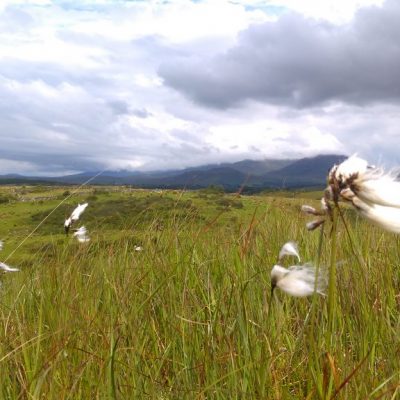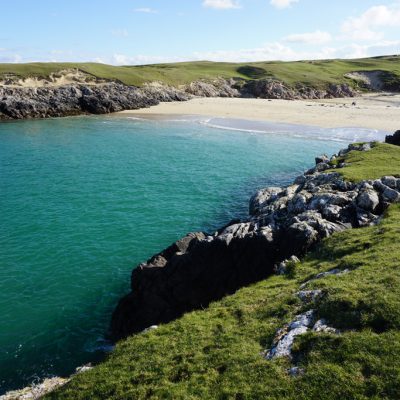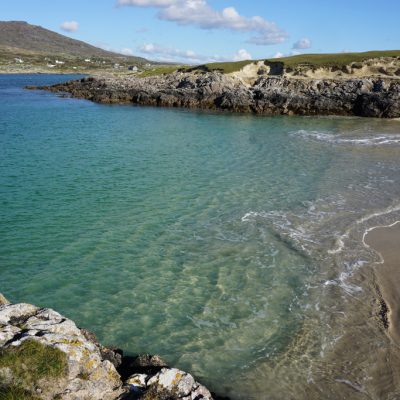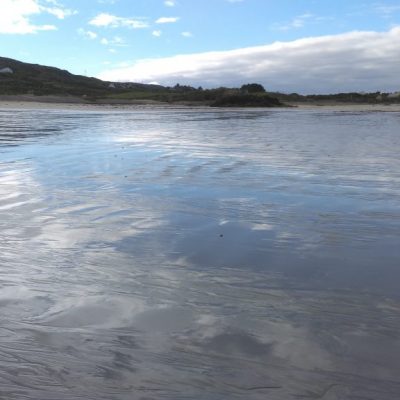Connemara
Connemara was described by Oscar Wilde as a ‘savage beauty’. The region of raw landscapes encompasses desolate boglands, amazing beaches and both the Maamturk and Twelve Bens mountain ranges. Lying on the very Western edge of Europe, it is home to some unique and exciting history, including two pioneering transatlantic projects.
Marconi Radio Station
Guglielmo Marconi caused a communications sensation when he transmitted wireless messages from his station at Poldhu in Cornwall to Newfoundland on 12th December 1901. Having received a grant of $80,000 from the Canadian Government to build a station at Glace Bay in Nova Scotia, he commenced the task of perfecting wireless communication with Poldhu from late 1902. He experienced extreme difficulty in providing commercially viable communications and decided to move his easterly station as far west as possible and decided on Clifden (Derrigimlagh) after making tests at a number of sites.
The station was not officially opened until 17th October 1907, when commercial signalling commenced between Clifden and Glace Bay. It was a sight to behold, with the huge condenser house building, the power house with its 6 boilers, and the massive aerial system consisting of 8 wooden masts, each 210 feet high extending eastwards over the hill for a distance of 0.5 kilometres. The aerials gave off sparks which could be heard in the distance, indicative of the huge power and voltages involved (150KW at 15,000 volts).
As time moved on, advances were made in the technology and a more powerful station was built at Caernarfon in North Wales. The Clifden station was attacked by republican forces in July 1922 and some buildings were damaged. The Marconi Company sought compensation from the new Free State government, but this did not materialise. The station was closed shortly after.
The remains of the station have lain dormant since the contents were sold for scrap after the closure. Employees of the station have passed away and regrettably, little has been done to record the details of what was a great industrial enterprise of the 20th century. The Clifden and Connemara Heritage Society have developed a discovery walk at the site which also is a memorial to Alcock and Brown, the pair to achieve the first transatlantic flight.
Text courtesy of Shane Joyce
First Transatlantic Flight
On June 15th 1919, Alcock and Brown crash landed their Vickers Vimy aircraft in Derrygimla Bog just south of Clifden, Connemara, Co. Galway after a harrowing sixteen hour flight from St. John’s, Newfoundland.
Capt. John Alcock and Lieut. Arthur Whitten-Brown, had set off from St. John’s the day before, on Saturday June 14th in a two-seater bi-plane. The aircraft, a Vickers Vimy, had been designed to fly long range bombing missions, and a lots modifications were needed for the attempt of the transatlantic flight.
The start of the flight was relatively trouble-free, apart from a prolonged take-off. It was not long before they ran into problems. Fog and cloud reduced visibility causing difficulty for Brown, who needed clear skies to navigate reliably. Next, the radio failed, and the starboard exhaust and silencer disintegrated, which made conversation impossible.
Weather conditions were also getting worse. Battered by hail, both men feared that the aircraft’s fabric outer would be torn. As the rain turned to snow, the controls began to freeze up and Brown, on six occasions, had to leave the cockpit and manually clear ice from the critical parts of the aircraft.
The men decided to land in County Galway so they turned slightly south of their course and made landfall at the entrance of Clifden Bay, flying over the Marconi Wireless Station, where they tried unsuccessfully to attract attention. They then headed for Clifden where they circled around the town and were observed by a number of townspeople. Hoping to find a suitable landing site they returned to the Marconi Station and mistook a stretch of bog for a smooth green landing strip. Although the nose of the plane sunk into the bog neither Alcock nor Brown suffered serious injury and their place in aviation history was secured. A cheque for £10,000, being the prize offered by THE DAILY MAIL, also awaited them in London.
Alcock and Brown left Clifden on the afternoon of Sunday 15th June, heroes to so many people for what they had achieved. They signed many autographs for countless numbers of people on their triumphant journey from Derrygimla, through Clifden, Galway, Dublin and on to London. Later in London they received the DAILY MAIL and other prize money totaling £13,000. They were also knighted by King George.
The Alcock & Brown monument is perched atop the High Road in Errislannan, overlooking the Derrygimlagh Bog, where these two men made aviation history.
Kylemore Abbey
Kylemore Abbey is home to a community of nuns of the Benedictine Order who came here in 1920 after their abbey in Ypres, Belgium was destroyed in World War I. Settling at Kylemore, the Benedictine Community opened a world renowned boarding school for girls and began restoring the Abbey, Gothic Church and Victorian Walled Garden to their former glory.
Kylemore’s foundation stone was laid on September 4th 1867 by Margaret Vaughan Henry, the wife of Mitchell Henry. The estate had been bought and planned as an elaborate love token for Margaret whom he brought to Ireland on honeymoon in the mid 1840s. Although they visited Connemara in a time of hunger, disease and desperation, Mitchell could see the potential to bring change and economic growth to the area.
The son of a wealthy Manchester cotton merchant of Irish origin, Mitchell was a skilled pathologist and eye surgeon. In fact before he was thirty years of age, he had a successful Harley street practise and is known to have been one of the youngest ever speakers at the Royal College of Surgeons in London. On his father’s death, Mitchell inherited a hugely successful family business and became one of the wealthiest young men in Britain at the time. Mitchell lost no time in quitting his medical career and turning instead to liberal politics where he felt he could change the world for the better. His new found wealth also allowed him to buy Kylemore Lodge and construct the magnificent Castle.
In 1874 just a few years after the castle was completed, the Henry family departed Kylemore for a luxurious holiday in Egypt. Margaret was struck ill while travelling and despite all efforts, nothing could be done and after two weeks of suffering she died. She was 45 years old and her youngest daughter, Violet, was just two years old. Mitchell was heartbroken. Margaret’s body was beautifully embalmed in Cairo before being returned to Kylemore. According to local lore Margaret lay in a glass coffin which was placed beneath the grand stair case in the front hall, where family and tenants alike could come to pay their respects. In an age when all funerals were held in the home, this is not as unusual as it may first seem. In time Margaret’s remains were placed in a modest red brick mausoleum in the woodlands of her beloved Kylemore.
Share:






